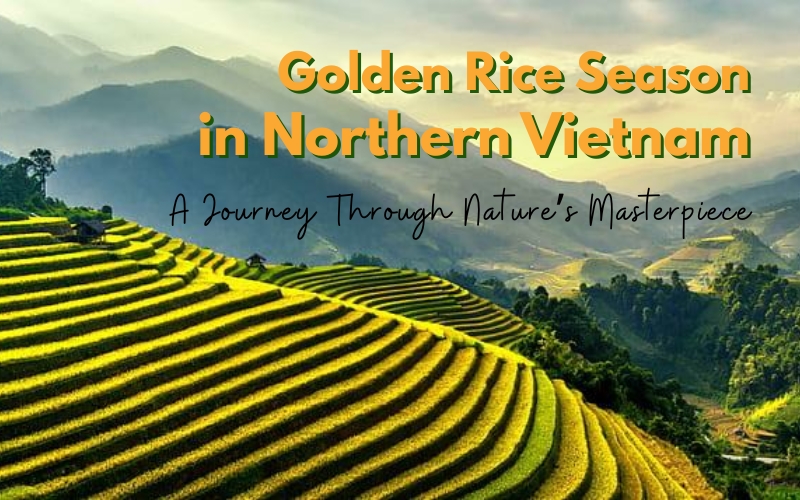
The golden rice season in Northern Vietnam is one of the most impressive sights that any tourist coming to Vietnam wishes to see. When the harvest season comes, the fields are covered in a golden color. The combination of the blue sky, green mountains, golden rice fields and ethnic houses will create a breathtakingly beautiful scene. If you are planning a trip and wondering which rice fields to see in Vietnam, this article will take you to the most beautiful places, the most ideal time to visit and tips to enjoy the beauty of Vietnam’s rice fields at their best.
When is golden rice season in Northern Vietnam?
At any time, the rice fields of Vietnam have a distinct beauty and bring different experiences. Therefore, you can visit all year round and in many different places during your Vietnam tour, except for a few rainy months in the Central region. However, if you want to admire the golden rice fields, if you want to encounter the terraced fields in peak season, I really recommend you to learn a little or even ask the locals or tour guides before going because each locality will have different harvest times depending on the weather and factors such as terrain, sowing time.
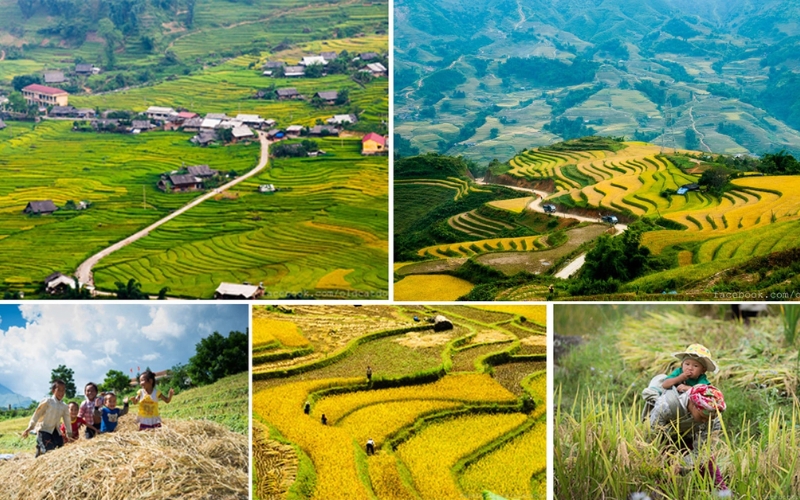
Golden rice fields in full bloom across Northern Vietnam
The rice harvest season in the northern regions of Vietnam usually takes place in the fall every year, lasting from August to the end of October. And from my own trip, I think that early to mid-October is the best time to go, when the weather is cooler, the sky is clear and sunny, very suitable for outdoor activities and long trips. During this time, you will have the opportunity to admire the golden, shimmering and brilliant rice fields against the vast sky. Blending into that charming scene are majestic mountain ranges, fog covering the foothills. All create a simple, rustic but extremely dreamy and romantic natural landscape.
What are best places to see golden rice fields in Northern Vietnam?
Northern Vietnam has some of the most breathtaking harvest season landscapes I’ve ever seen, and trust me, it’s even more magical in real life. Based on my own trip, here are the best spots to catch that golden glow at just the right time.
Mu Cang Chai
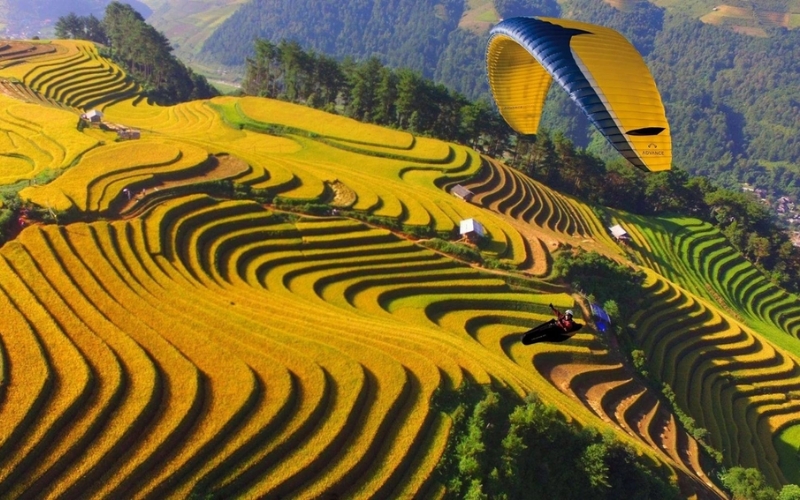
Terraced rice fields glowing gold in Mu Cang Chai
Best time: mid-September to early October
How to get there: You can take a bus from Hanoi to Than Uyen and then continue to Mu Cang Chai. Or you can go to Yen Bai, rent a motorbike and explore
If you are planning to visit Northern Vietnam, make sure you don’t miss Mu Cang Chai, which is among world’s 50 most beautiful places. With its wild nature and challenging trails, the golden terraced fields in Mu Cang Chai have been listed as one of the most majestic landscapes in the world. I had the chance to visit in late September, and honestly, this is one of the most breathtaking places I have ever seen. These terraced fields are considered masterpieces of the Hmong people and are an important part of their culture.
During the harvest season, this land takes on a majestic beauty with golden rice fields stretching over 2000 hectares. The combination of cool air, golden rice fields and majestic highland landscapes makes this place a favorite destination for photographers and nature lovers. This is our top recommended travel destination for travelers who want to admire the golden terraced fields in Vietnam.
> > > To make the most of Mu Cang Chai’s golden rice season, consider joining the Mu Cang Chai’s Ripe Rice Season in 3 Days tour. It’s a great way to explore the region’s most stunning terraces, local villages, and scenic mountain roads, all without worrying about the logistics. If you’re short on time but still want a full and memorable experience, this tour is a solid choice.
Sapa
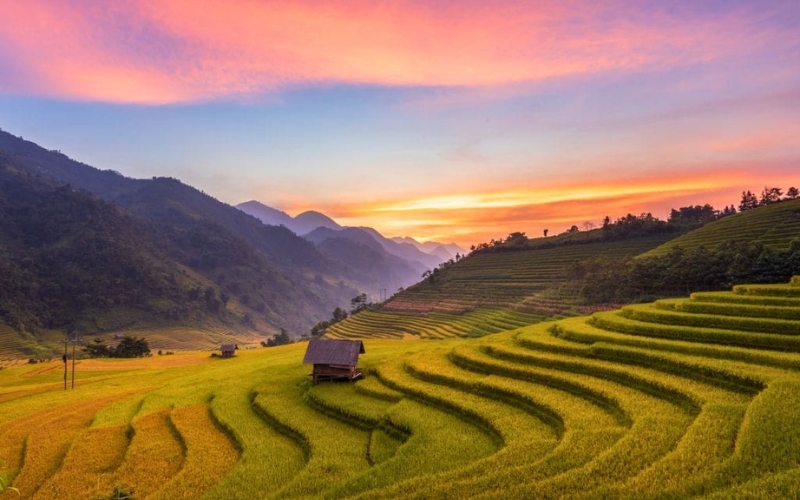
A peaceful sunset overlooking the ripe rice fields in Lao Chai Village, Sapa
Best time: May – June or September to early October
How to get there: Take a night train or luxury sleeper bus from Hanoi, then take a shuttle bus or taxi from Lao Cai station to Sa Pa town in about 1 hour. Or you can choose to take a private car or bus from Hanoi, which takes about 5-6 hours.
It is no coincidence that Sa Pa has become the most famous destination for international tourists to see golden ripe rice fields in Vietnam. When I came here during the ripe rice season, I understood why Sa Pa is known as one of the most beautiful terraced fields in Asia and the world. From above, the terraced fields stretch along the mountainside, winding and intertwining to create beautiful shapes. Among the fields, you can see the simple houses of ethnic minorities living in Sa Pa, water buffaloes and farmers. Famous rice fields in Sa Pa include Lao Chai, Ta Van and Ta Phin villages. These places are ideal for hiking, cycling, or even staying overnight at homestays.
A trekking trip in Sa Pa will take you to ethnic minority villages on beautiful green terraced fields with majestic views of the mountains. What I enjoyed most was not only the scenery, but also the opportunity to meet ethnic minority communities such as the Hmong, Red Dao and Tay. Many local families still cultivate the terraced fields by hand, giving visitors a genuine glimpse into rural life.
Ninh Binh
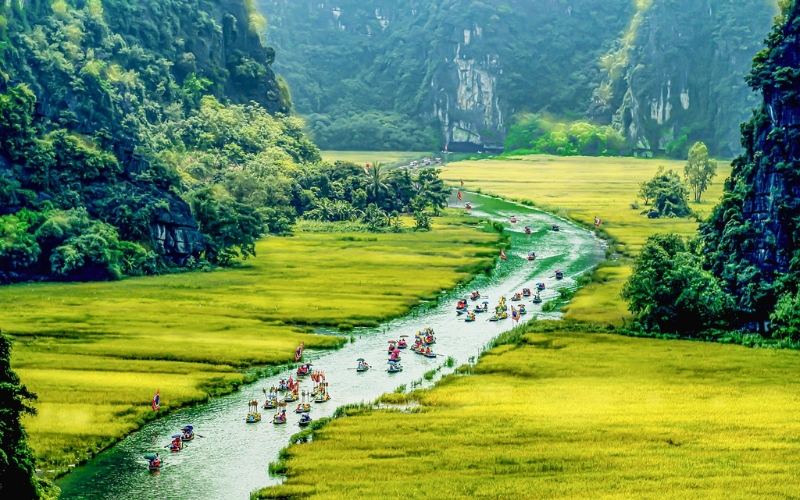
Scenic view of rice fields and karst mountains in Tam Coc, Ninh Binh
Best time: late May to early June
How to get there: You can easily reach Ninh Binh from Hanoi via train, car, bus, or even motorbike, in just about 2 hours.
If you are short on time but still want to witness the golden rice season of Northern Vietnam, Ninh Binh is the perfect choice. Dubbed the “Halong Bay on land”, it offers a magical combination of majestic limestone mountains, lush valleys and vast rice fields.
I visited Tam Coc in late May and the scenery was unforgettable. The rice fields turned brilliant green and gold, sparkling against the sky. You can choose to admire the panoramic view of Tam Coc rice fields from the top of the mountain or take a boat trip along the Ngo Dong River, passing through the rice fields, sometimes close enough to touch the swaying stalks in the wind. It is quiet, peaceful, and feels like you are stepping into a painting.
Mai Chau
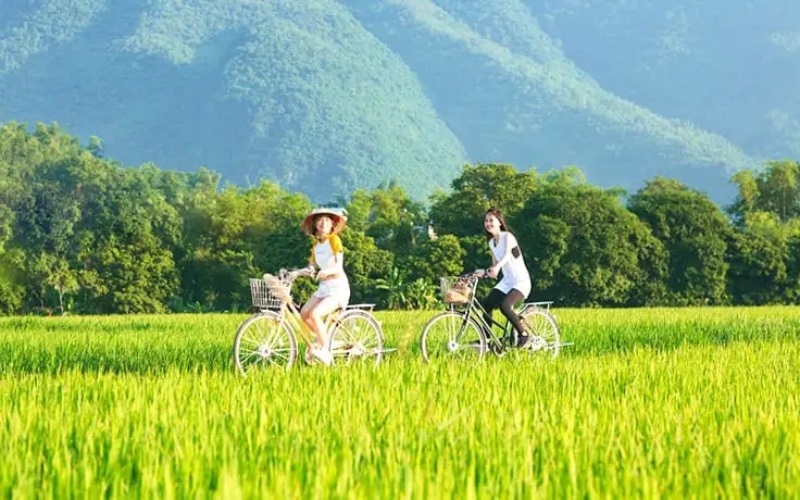
Biking through the golden fields of Mai Chau
Best time: Late May to early June or September to October
How to get there: To get to Mai Chau from Hanoi, you can take a bus or shuttle (3–4 hours) from My Dinh station or via your hotel, or drive via Highway 6 by car or motorbike (2–3.5 hours) for a more flexible and scenic journey.
While it lacks the majestic terraced fields of the highlands, Mai Chau’s flat, green fields offer a peaceful rural scene. Nestled in a tranquil valley surrounded by towering limestone mountains, Mai Chau boasts rice paddies stretching across villages. It’s a great stop for those who want to enjoy the rice paddies of Vietnam without having to trek up the mountains or into the highlands.
Mai Chau is also home to the Thai people, who are famous for their stilt houses, hand-woven textiles, and warm hospitality. What makes the trip even more special is the opportunity to stay overnight at a Thai homestay. The family I stayed with were incredibly warm and hospitable, cooking sticky rice over firewood, drinking local wine (yes, it’s very strong!), and even inviting us to join in a traditional dance. The moment of waking up in the mist covering the rice fields is an unforgettable memory for me.
Hoang Su Phi
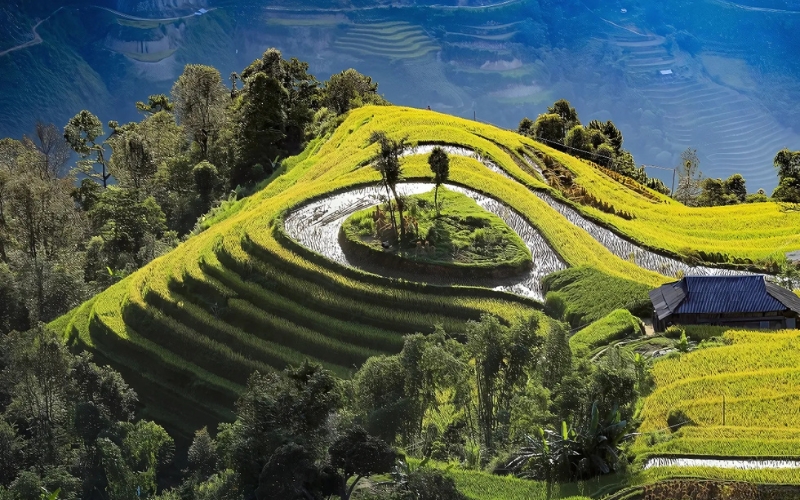
Sunlight over the rice terraces of Hoang Su Phi
Best time: Mid-September to early October
How to get there: You can take the morning bus or VIP shuttle, which takes about 7–8 hours, winding through the spectacular terraced hills.
With its complex terrain, including high mountains and gentle slopes, Ha Giang has become one of the most popular tourist destinations in recent years, especially for young adventurous travelers because of the majestic beauty of Ha Giang’s rice fields. In particular, the Hoang Su Phi area is most famous for its large and highest terraced fields in Vietnam. Unlike other tourist destinations, Hoang Su Phi feels more remote and less commercialized, you will probably admire this scene with farmers rather than tourists.
The terraced fields here are spectacularly layered on steep mountain slopes, and you can see local ethnic groups such as the Dao and La Chi people working on them. The vast stretches of rice fields, often shrouded in mist, create a surreal and majestic atmosphere, even more breathtaking at sunrise and sunset. I recommend visiting villages like Ban Phung, Nam Hong, Nam Ty and Thong Nguyen. Getting there is not easy, you need to get used to riding a motorbike or walking through narrow, winding roads. But trust me, the journey itself is part of the adventure. Just avoid coming here during the rainy season (June to August) as the trails are slippery and the risk of landslides is high.
Y Ty
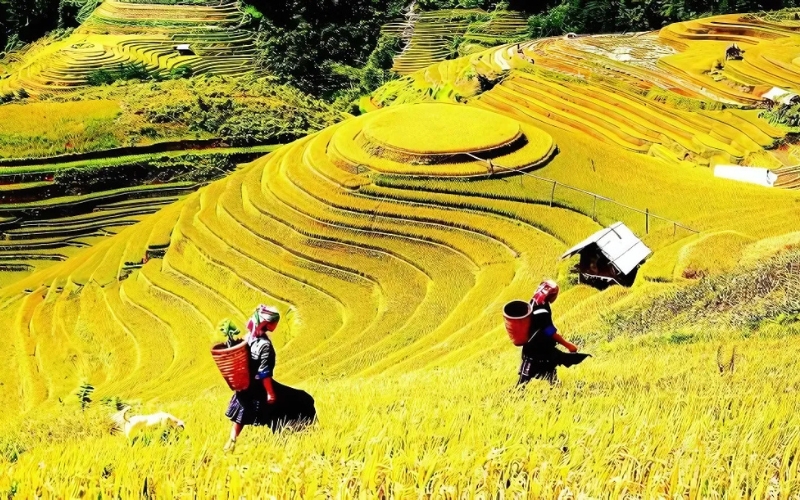
Harvest season on the terraced fields of Y Ty
Best time: Late September to early October
How to get there: From Hanoi, you can take an overnight train or limousine to Lao Cai, then catch a bus or rent a motorbike to Y Ty.
Located in the far north of Vietnam, about 70km from Sa Pa, Y Ty is still one of the least known places to see terraced fields. Situated at an altitude of more than 2,000 meters, this place offers a peaceful, wild scene, different from the bustling Sa Pa. Known as “paradise”, “where the earth and sky become one”, coming here, you will admire the gently sloping terraced fields stretching to the horizon. I came here at the end of September, just when the terraced fields turned a brilliant yellow, feeling like stepping into a painting. You will have the opportunity to take pictures of the clouds drifting over the fields, something that cannot be found anywhere else in Vietnam.
For adventurous travelers, Y Ty is also the starting point for trekking to Lao Than peak (2860m). This trekking route is quite familiar to beginners, but still requires participants to practice regularly to have the best preparation. I hiked to watch the sunrise, and watching the sea of clouds under the golden mountain slopes was one of the most magical travel moments I have ever had in Vietnam.
Pu Luong
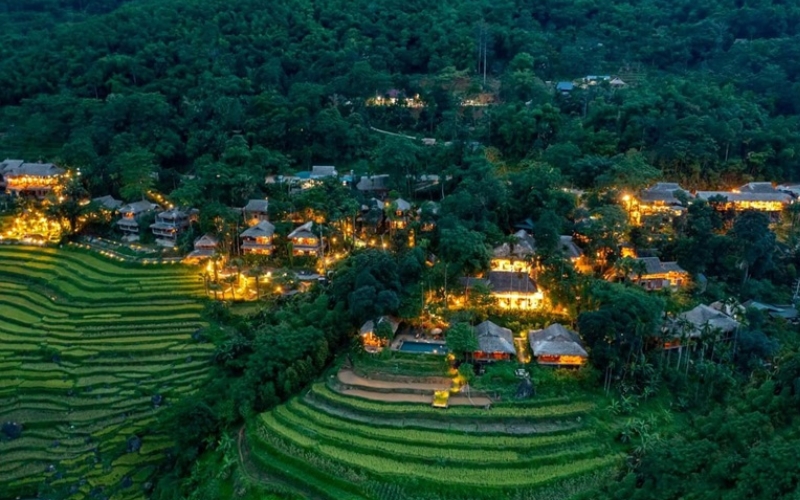
Pu Luong valley view from an eco-resort
Best time: May to June and September to October
How to get there: From Hanoi, you can take a limousine or private car for 4 hours. You can also get here from Ninh Binh in 2 hours, depending on the route.
Pu Luong is one of the most popular rice-season destinations for international tourists recently. Nestled in the mountains of Thanh Hoa, Pu Luong is like a hidden gem with a peaceful space and impressive terraced fields stretching across the hillsides, perfectly blending with bamboo forests and stilt houses.
Pu Luong also has a system of high-class resorts and motels designed with a harmonious space, close to nature. I stayed at a small eco-lodge with a balcony overlooking the terraced fields, and waking up to the gentle sunlight shining down on the golden terraced fields was an unforgettable moment. The connection with nature here is so close and genuine. This is the perfect place to slow down, take a hike and get some fresh air.
Bac Son Valley
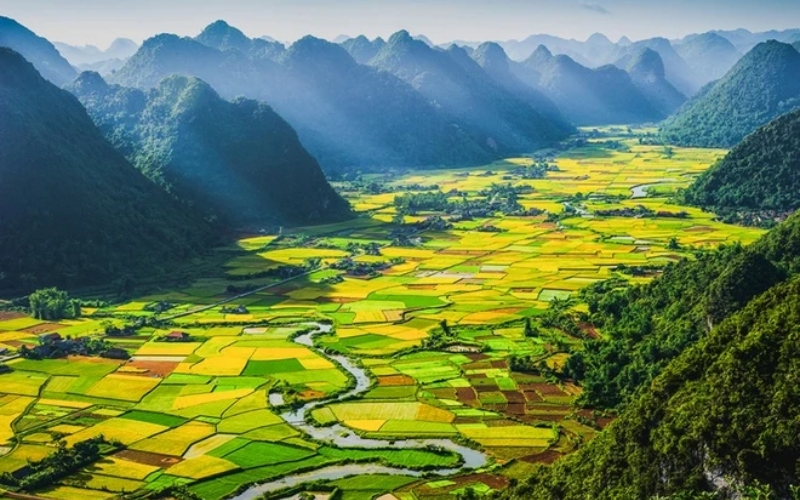
Bac Son Valley’s colorful rice landscape from above
Best time: late July to mid-November
How to get there: You can reach Bac Son Valley from Hanoi by bus, shared minivan, or private car, the journey takes about 3.5 to 4.5 hours.
Bac Son Valley is located in the center of Bac Son District, Lang Son Province, in the Northeast of Vietnam, about 250 km from Hanoi. Surrounded by limestone mountains and scattered Tay ethnic villages, the valley offers a spectacular natural landscape, where rice fields stretch in all directions, creating cool green and golden patches. The terraced fields in Bac Son have their own unique features, with golden ripe terraced fields dotted with lush green fields. This is because people here cultivate at different times, and that is also the reason why Bac Son Valley is one of the most ideal places to admire the golden ripe rice fields.
To get the best view, I climbed to the top of Na Lay just before dawn. The hike isn’t too difficult (about 30-40 minutes if you walk slowly), and the rewards are incredible: mist shrouding the limestone mountains, endless golden fields below, and absolute silence except for a few birds and a rooster crowing in the distance. If you’re feeling adventurous, bring a sleeping bag and camp overnight, waking up to that view is something I’ll never forget.
Suggested tours to Northern Vietnam in golden rice season
If you’ve ever dreamed of seeing the golden rice terraces for yourself, I highly recommend it – it’s one of the most breathtaking sights I’ve ever seen in Vietnam. To help you make the most of the harvest season, here are some handpicked tours of Northern Vietnam that will take you right into the heart of the harvest beauty.
Itinerary 1: 15 Days Adventure Tour Northeast and Northwest Vietnam

Day 1: Hanoi – Mai Chau valley
Day 2: Mai Chau – Son La
Day 3: Son La – Dien Bien Phu
Day 4: Dien Bien Phu – Lai Chau
Day 5: Lai Chau – Sin Ho – Tam Duong
Day 6: Tam Duong – Sapa
Day 7: Sapa
Day 8: Sapa – Bat Xat – Lao Cai
Day 9: Lao Cai – Bac Ha
Day 10: Bac Ha – Hoang Su Phi – Ha Giang
Day 11: Ha Giang – Sa Phin – Dong Van
Day 12: Dong Van – Meo Vac
Day 13: Meo Vac – Bao Lac – Ba Be Lakes
Day 14: Ba Be Lakes
Day 15: Ba Be lakes – Hanoi
For a more detailed itinerary, please check this link here.
> > > If that itinerary caught your interest, just know it’s only one of many ways to experience the magic of Northern Vietnam. From short getaways to extended cultural adventures, we have plenty of Northen Vietnam tours designed to help you explore the golden rice fields, mountain landscapes, and ethnic villages, each offering a different perspective on this breathtaking region.
Itinerary 2: Discovering Tour to Colorful Northern Vietnam in 12 Days
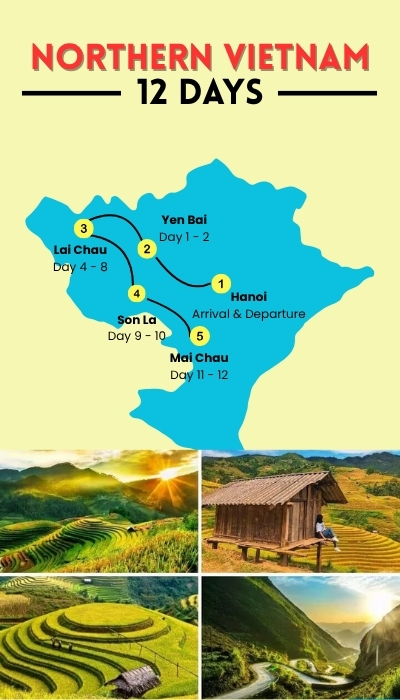
Day 1: Hanoi arrival
Day 2: Hanoi – Yen Bai – Nghia Lo
Day 3: Nghia Lo – Mu Cang Chai – Than Uyen
Day 4: Than Uyen – Binh Lu
Day 5: Binh Lu – Sin Ho
Day 6: Sin Ho – Muong Te
Day 7: Muong Te
Day 8: Muong Te – Lai Chau
Day 9: Lai Chau – Son La
Day 10: Son La – Mai Chau
Day 11: Mai Chau – Hanoi
Day 12: Hanoi – Departure
For a more detailed itinerary, please check this link here.
Tips when visiting rice fields in Northern Vietnam
Visiting the rice terraces during the golden rice season is truly an unforgettable experience with breathtaking scenery, and an almost magical atmosphere. To make the most of your trip, here are some useful tips from my own experience and things I wish I had known before going:
- Choose the right time to visit: If there’s one thing I learned from chasing golden rice fields – it’s all about timing. The golden rice season only lasts a few weeks and the ripening time varies depending on the region and the weather. So before finalizing your travel date, contact your local guide or accommodation. They know exactly when the rice is turning that perfect shade of gold.
- Best time of day to visit: Trust me on this: catching the sunrise or sunset over the rice terraces is a moment you won’t forget. With the soft light, cool and peaceful atmosphere, this is also a great time to take photos, with gentle mist and golden rays of sunlight stretching across the terraced fields. Avoid visiting at noon, as the sun is harsh and there is little shade, making photography difficult and outdoor activities tiring.
- Note about the weather: The weather can be quite unpredictable, from scorching heat to sudden showers, so planning ahead is important. During my trip to Y Ty, we got caught in a sudden mountain rainstorm and had to wait it out in a roadside café. Stay up to date with local weather information and avoid travelling through remote highlands during or after heavy rains. And remember, if the weather looks too harsh, you can always cancel your plans. Vietnam is still there waiting to be explored. Your safety is the top priority.
- Prepare the right equipment: The climate in the North in late autumn is often quite cold, especially at night. I made the mistake of packing too light once, don’t be me. You should bring jackets, long-sleeved shirts,… to keep warm. The roads to the terraced fields and rice fields are quite bumpy and dangerous, so avoid wearing high heels or sandals. Instead, wear non-slip sneakers for easy movement.
- Photography tip: Vietnam’s golden rice fields are a photographer’s dream. If you use a drone to take photos, remember to check local regulations. While drones are allowed in many rural areas, some areas, especially near the border like Y Ty or Hoang Su Phi, may require permission.
- Hire a local guide: Sure, you can go solo, but having a local guide was one of the best decisions I made. They will show you easier trails and provide some interesting information about the local ethnic minorities. Our guide even invited us to his home for tea and sticky rice, it turned into one of the most heartwarming memories of the trip.
- Respect the local culture: Northern Vietnam is home to many ethnic minority communities such as the Hmong, Dao, and Tay. These villages are very hospitable, but it is important to be respectful. Dress modestly, especially when staying overnight in a homestay and always ask before taking photos of people. I’ve found that most people are happy to be photographed if you smile and ask kindly first.
Hopefully this guide has given you a good idea of what makes the golden rice season in Northern Vietnam special and how to experience it in the most memorable way. With the right timing, a little planning and an open mind, your trip through the rice terraces and peaceful villages will be an unforgettable one. Still not sure where to start or want some help planning the perfect trip? Contact us now – we’d love to help you plan a personalized itinerary and make your golden rice season adventure an unforgettable experience.
Read more:
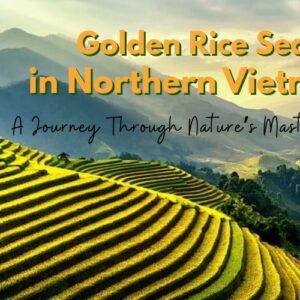
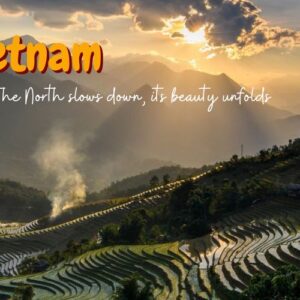

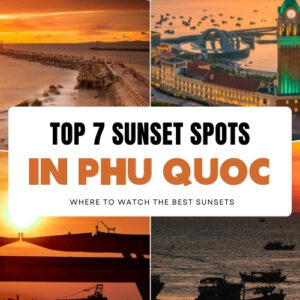
Is it the rainy season in Vietnam? I really want to visit ethnic minority villages in Sapa in the golden rice season by motorbike; however, I am worried about the slippery dirt road. Do you have any suggestions?
Hi Lucas,
Thank you for reaching out to us! In northern Vietnam, including Sapa, the rainy season typically lasts from May to September, which also happens to be when the rice terraces look their most beautiful. If you plan to explore the ethnic minority villages by motorbike, be mindful that dirt roads can become very slippery during wet weather. To make the most of your trip, try to go toward the end of the rainy season, rent a motorbike with good tires, start your rides earlier in the day to avoid afternoon showers. Consider combining motorbiking with short treks led by local guides who know the safest routes.
Hope this helps!
Best regards,
IDC Travel Team.